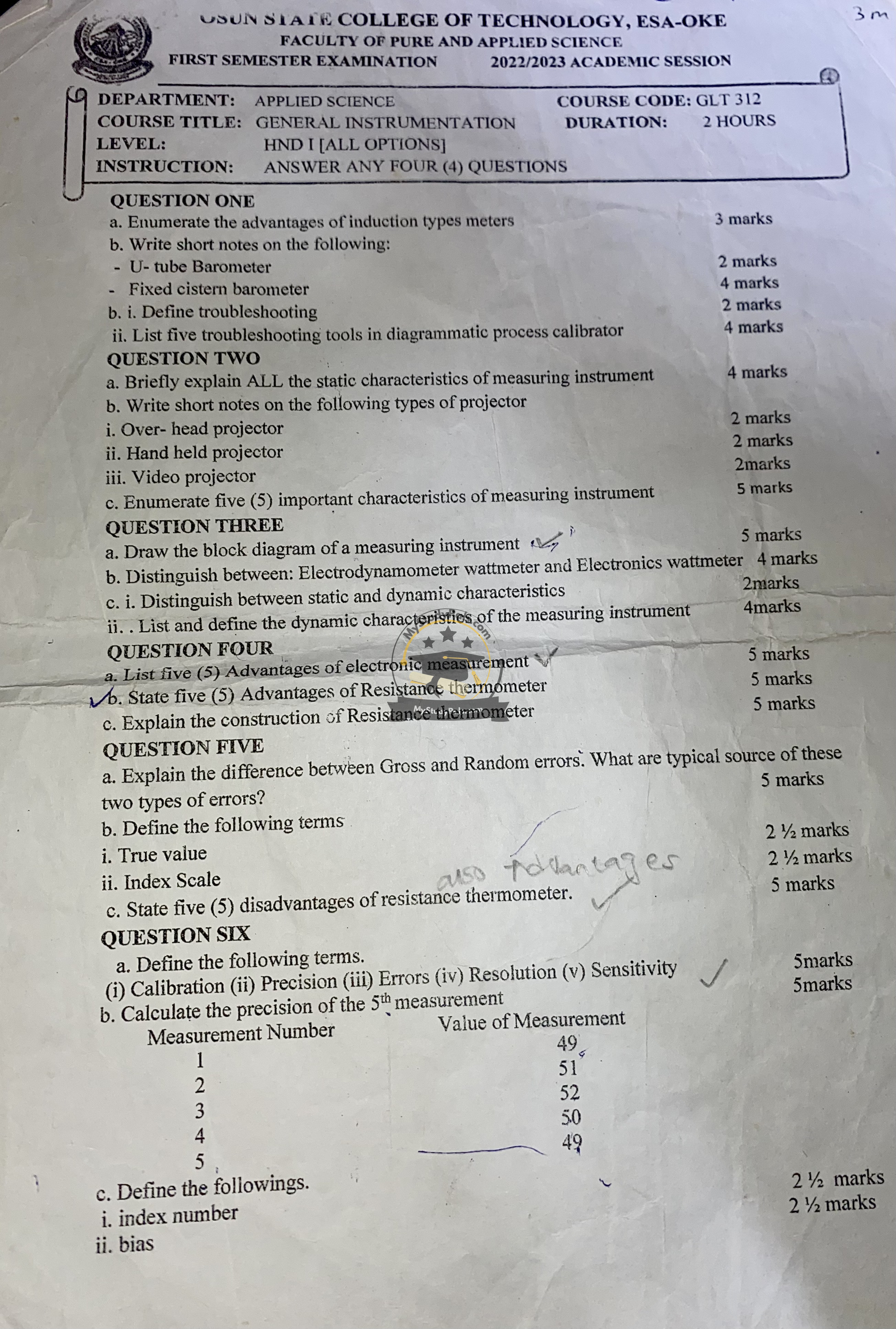ANWSER
—
Question 1:
a. Advantages of induction-type meters:
– High accuracy and reliability.
– Robust construction, making them durable.
– Suitable for both AC and DC measurements.
– Low maintenance requirements.
– Good overload capacity.
b. Short notes:
– U-tube Barometer: A simple device used to measure atmospheric pressure by balancing a column of liquid (usually mercury) in a U-shaped tube against the atmospheric pressure.
– Fixed cistern barometer: A type of barometer where one end of the tube is fixed into a cistern of mercury, and changes in atmospheric pressure cause the mercury level in the tube to rise or fall.
c. Troubleshooting:
i. Definition: The process of identifying, diagnosing, and resolving problems or malfunctions in a system or equipment.
ii. Five troubleshooting tools in a diagrammatic process calibrator:
– Multimeter
– Oscilloscope
– Signal generator
– Pressure calibrator
– Temperature calibrator
—
Question 2:
a. Static characteristics of measuring instruments:
– Accuracy: Closeness of the measured value to the true value.
– Precision: Consistency of repeated measurements.
– Sensitivity: Ratio of the change in output to the change in input.
– Resolution: Smallest detectable change in the measured quantity.
– Linearity: Degree to which the output is proportional to the input.
– Hysteresis: Dependence of the output on the direction of input change.
– Repeatability: Ability to produce the same output for repeated identical inputs.
b. Short notes on projectors:
i. Over-head projector: Projects images or text from transparencies onto a screen, commonly used in presentations.
ii. Hand-held projector: A portable device that projects images or videos onto a surface, often used for small-scale presentations.
iii. Video projector: Projects video signals from a source (e.g., computer, DVD player) onto a large screen, used in theaters and classrooms.
c. Five important characteristics of measuring instruments:
– Accuracy
– Precision
– Sensitivity
– Resolution
– Repeatability
—
Question 3:
a. Block diagram of a measuring instrument:
[Input Signal] → [Sensor/Transducer] → [Signal Conditioner] → [Output Display/Recording]
b. Difference between Electrodynamometer wattmeter and Electronic wattmeter:
– Electrodynamometer wattmeter: Uses a moving coil and fixed coils to measure power, suitable for AC and DC, but less accurate for high frequencies.
– Electronic wattmeter: Uses electronic components (e.g., multipliers, ADCs) for power measurement, more accurate, and suitable for a wide frequency range.
c. Static vs. Dynamic characteristics:
i. Static characteristics: Pertain to measurements where the input is constant or varies slowly.
ii. Dynamic characteristics: Pertain to measurements where the input varies rapidly, including:
– Speed of response: How quickly the instrument responds to changes.
– Bandwidth: Range of frequencies the instrument can measure.
– Time lag: Delay between input change and output response.
—
Question 4:
a. Advantages of electronic measurement:
– High accuracy and precision.
– Fast response time.
– Ability to measure a wide range of quantities.
– Easy integration with digital systems.
– Minimal human error.
b. Advantages of Resistance Thermometer:
– High accuracy and stability.
– Wide temperature range.
– Good repeatability.
– Suitable for precise measurements.
– Can be used in harsh environments.
c. Construction of Resistance Thermometer:
– Consists of a platinum wire wound around a ceramic or glass core.
– The wire is encapsulated in a protective sheath (e.g., stainless steel).
– Leads are connected to measure resistance changes due to temperature.
—
Question 5:
a. Difference between Gross and Random errors:
– Gross errors: Caused by human mistakes (e.g., incorrect readings or recording).
– Random errors: Unpredictable variations due to environmental or instrumental factors.
Sources:
– Gross errors: Human oversight, faulty equipment.
– Random errors: Noise, temperature fluctuations.
b. Definitions:
i. True value: The theoretically correct or accepted value of a measured quantity.
ii. Index Scale: A scale used to reference or compare measurements.
c. Disadvantages of Resistance Thermometer:
– Expensive compared to other thermometers.
– Requires external power supply.
– Fragile construction.
– Slow response time.
– Affected by electrical noise.
—
Question 6:
a. Definitions:
(i) Calibration: Process of comparing an instrument’s output to a known standard to ensure accuracy.
(ii) Precision: Consistency of repeated measurements.
(iii) Errors: Deviation of measured value from the true value.
(iv) Resolution: Smallest detectable change in the measured quantity.
(v) Sensitivity: Ratio of output change to input change.
b. Precision of the 5th measurement:
– Calculate the average of the measurements:
\[
\text{Average} = \frac{49 + 51 + 52 + 50 + 49}{5} = 50.2
\]
– Precision for the 5th measurement (49):
\[
\text{Precision} = \frac{49}{50.2} \approx 0.976 \text{ (or 97.6%)}
\]
c. Definitions:
i. Index number: A statistical measure representing changes in a variable over time.
ii. Bias: Systematic deviation of measurements from the true value.
—


